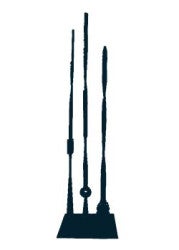Explain to your child that when we listen to different kinds of music, the beat can be fast or slow. The speed of the beat is called rhythm. Sometimes artists will repeat the same part several times in order to create a visual flow. This is also called rhythm.
This artist creates a visual flow by repeating certain parts. By using more than one column in this sculpture, she creates a regular visual flow with three repetitions.
What does this sculpture look like?
What parts are repeated? How many times?
If this sculpture were a piece of music, how would it sound? Would it be fast or slow?
Did the artist give this sculpture a good name? Why or why not?
Distance, quantity, and scale can alter the way we read visual rhythm. Note that the repetition of forms look different if they are large or small, close together or far apart, and if there are less or more forms repeated.
Ask your child to vocalize visual rhythms. Walk around and point at repeated forms and express them in sound. Suggest higher, faster sounds for small repeated objects (like books on a shelf) and lower, slower sounds for large repeated objects (like electrical poles). Then make a drawing in which the child repeats forms, such as circles, lines, or squiggles. Encourage him or her to vocalize appropriate sounds while drawing.
Artist - someone who makes things, such as paintings and sculptures
Column - a tall shaft that holds something up, usually the front of a building
Repetition - the act of repeating something over and over
Rhythm - the flow of repeated things that are alike
Sculpture - a work of art that has height, width, and depth
Unity - bringing parts together

